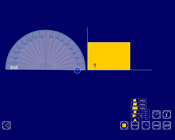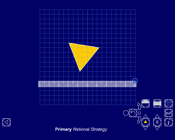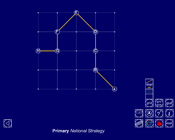Consolidation and practice
These resources are to support children in guided or independent work.
Calculating angles

This interactive teaching program (ITP) is an ICT-based tool to support the exploration of angles. Calculating angles ITP allows the child or teacher to represent single or multiple shapes rotated around a central point in one, two or four quadrants. The size of angles can be estimated or calculated and confirmed using the on-screen protractor or reveal function.
Polygon

This interactive teaching program (ITP) is an ICT-based tool to support the exploration of shape, space and measure. Polygon ITP allows the child or teacher to represent regular polygons with three to ten sides. The ITP can then be used to explore the properties of regular and irregular shapes by dragging vertices and creating additional vertices. The ITP includes an on-screen protractor and ruler.
Fixing points

This interactive teaching program (ITP) is an ICT-based tool to support the exploration of shape and space. Fixing points ITP allows the child or teacher to create one or more shapes by connecting a number of vertices on a grid. Angles can be estimated and measured, and the effect of moving different vertices can be explored.
Opportunities to use and apply
Possible contexts include:
- number challenges, e.g. Three-quarters of a number is 48. What is the number? Explain your thinking.
- money problems, e.g. Over one year I have saved £194.40 by saving the same amount each month. If I carry on saving the same amount for the next five months, how much will I have altogether?
- measures problems, e.g. Jay buys a 2-litre bottle of milk. He uses 1/4 of it in cooking and he drinks 1/10 of it. How many millilitres are left?
- completing number sentences, e.g. Find different ways to complete:

Confirming learning
Ask probing questions such as:
- What operation must you use to find 1/7 of a number?
- What calculation would you key into a calculator to find 1/13 of 403?
- I used a calculator to work out 5/8 of £58 and got an answer of 92.8. What might I have done wrong? Explain how you would use your calculator to solve this problem.
- Explain how you would solve this problem: ‘There are 24 coloured cubes in a box. Three-quarters of the cubes are red, four of them are blue and the rest are green. How many green cubes are in the box?’
 is 10.
is 10. Calculating
Calculating



